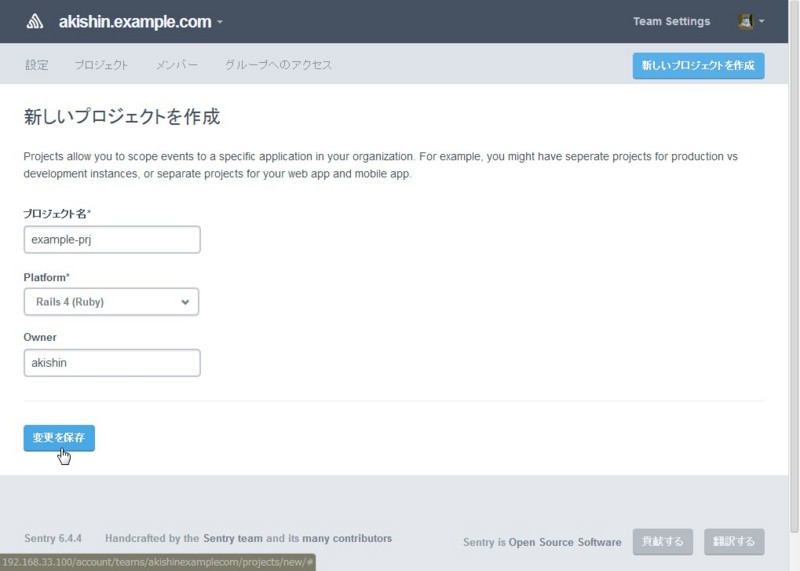Sentry をインストール
商用サービスもあるオープンソースのイベントログ収集ツール Sentry をインストールしてみたのでメモ。
getsentry/sentry
https://github.com/getsentry/sentry
Airbrake やオープンソースの Errbit 辺りと同じ系統のサービスな感じです。
インストールした環境は CentOS 6.5 x86_64 です。
MySQL のインストール
まずは MySQL をインストール。
5.1 で試したら途中 sentry upgrade 実行時にエラーになったので、公式リポジトリから 5.6 を入れました。
# yum install -y http://dev.mysql.com/get/mysql-community-release-el6-5.noarch.rpm # yum install -y mysql-community-server mysql-community-devel
設定ファイルを変更。
# vi /etc/my.cnf
mysqld セクションに以下を追記します。
[mysqld] character-set-server = utf8
mysqld を起動。
# service mysqld start
起動したら mysql_secure_installation を実行し root パスワードの設定などを行っておきます。
# mysql_secure_installation
mysql_secure_installation の実行が終わったら設定したパスワードでログインします。
# mysql -uroot -p
sentry 用の DB とユーザを作成します。
パスワード等は適宜変更して下さい。
mysql> CREATE DATABASE IF NOT EXISTS sentry DEFAULT CHARACTER SET utf8; mysql> GRANT ALL PRIVILEGES ON sentry.* TO sentry@localhost IDENTIFIED BY 'sentry'; mysql> FLUSH PRIVILEGES; mysql> exit
Sentry のインストール
setuptools をインストール。
# yum install -y python-devel python-setuptools
easy_install コマンドを使って Sentry をインストールします。
# easy_install -UZ sentry[mysql]
インストール完了までそれなりに時間がかかるので、しばらく待ちます。
インストールが完了したら、以下のコマンドを実行して設定ファイルを作成。
# sentry init /etc/sentry.conf.py
作成した設定ファイルを編集します。
# vi /etc/sentry.conf.py
以下の箇所を先ほど作成したデータベース接続情報に変更します。
DATABASES = { 'default': { 'ENGINE': 'django.db.backends.mysql', 'NAME': 'sentry', 'USER': 'sentry', 'PASSWORD': 'sentry', 'HOST': 'localhost', 'PORT': '3306' } }
また、設定ファイル内の SENTRY_URL_PREFIX の値をインストールしたサーバのホスト名または IP アドレスに変更します。
#SENTRY_URL_PREFIX = 'http://sentry.example.com' # No trailing slash! SENTRY_URL_PREFIX = 'http://192.0.2.1' # No trailing slash!
設定ファイルを保存したら DB のマイグレーションなどを実行する upgrade コマンドを作成した設定ファイルを指定して実行します。
# sentry --config=/etc/sentry.conf.py upgrade
createsuperuser サブコマンドを実行して管理用のユーザを作成します。
# sentry --config=/etc/sentry.conf.py createsuperuser !!!!!!!!!!!!!!!!!!!!!!!!!!!!!!!!!!!!!!!!! !! SENTRY_URL_PREFIX is not configured !! !!!!!!!!!!!!!!!!!!!!!!!!!!!!!!!!!!!!!!!!! Username: akishin Email address: akishin@example.com Password: Password (again): Superuser created successfully.
これでインストールは完了です。
以下のコマンドでサーバを起動するとポート 9000 番で Sentry が起動します。
# sentry --config=/etc/sentry.conf.py start
軽く試すだけならこのままでも問題ないと思いますが、このままだと起動・終了が面倒なので、supervisord でプロセスを管理するよう設定します。
起動が確認できたら一旦 Ctrl-C などで sentry サーバを停止しておきます。
sentry を supervisor で管理する
以下のコマンドで supervisor をインストールします。
# easy_install supervisor
設定ファイルを作成。
# echo_supervisord_conf > /etc/supervisord.conf
作成した設定ファイルを編集します。
# vi /etc/supervisord.conf
ファイル末尾の以下の行をアンコメントし、ディレクトリパスを修正します。
[include] files = /etc/supervisord.d/*.conf
設定ファイルで指定したディレクトリを作成。
# mkdir /etc/supervisord.d
supervisor 用の起動スクリプトを clone して設置します。
# cd /usr/local/src/ # git clone git://github.com/Supervisor/initscripts.git # cp initscripts/redhat-init-jkoppe /etc/init.d/supervisord # cp initscripts/redhat-sysconfig-jkoppe /etc/sysconfig/supervisord # chkconfig --add supervisord
このままではデフォルトの設定ファイルと pid ファイルの場所が異なるので、以下を編集します。
# vi /etc/sysconfig/supervisord
ここでは /etc/supervisord.conf 側に合わせたので、以下のように変更しました。
#PIDFILE=/var/run/supervisord.pid PIDFILE=/tmp/supervisord.pid
これで supervisor の準備は出来たので、Sentry 用の設定ファイルを作成します。
# vi /etc/supervisord.d/sentry.conf
以下のような内容にしました。
[program:sentry-web] command=/usr/bin/sentry --config=/etc/sentry.conf.py start http user=sentry autostart=true autorestart=true redirect_stderr=true stdout_logfile=/var/log/sentry-web.log
指定した起動用ユーザを作成します。
# useradd -s /sbin/nologin -M sentry
supervisord を起動します。
# service supervisord start
Starting supervisord:
sentry-web STARTING
これで supervisord 経由で sentory の起動・停止が出来るようになりました。
Nginx の設定
このままでは 9000 番ポートを指定してアクセスする必要があります。
80 番ポートでアクセスできるようにするため、Nginx 経由で Sentry にアクセスできるように設定します。
まずは Nginx をインストール。
# yum install -y http://nginx.org/packages/centos/6/noarch/RPMS/nginx-release-centos-6-0.el6.ngx.noarch.rpm # yum install -y nginx
設定ファイルを編集します。
# vi /etc/nginx/conf.d/default.conf
location / の設定を以下のように変更しました。
location / { proxy_pass http://localhost:9000; proxy_redirect off; proxy_set_header Host $host; proxy_set_header X-Real-IP $remote_addr; proxy_set_header X-Forwarded-For $proxy_add_x_forwarded_for; proxy_set_header X-Forwarded-Proto $scheme; }
設定したら Nginx を起動します。
# service nginx start
以上で Sentry のインストールは完了です。
これでブラウザからポート 9000 を付けなくても Sentry にアクセス出来るようになります。
アクセスするとログイン画面が表示されるので、作成したユーザ情報でログインします。
ログインすると、初回ログインではチームの作成画面が表示されます。
チームを作成すると次はプロジェクト作成画面が表示されます。
プロジェクトを作成すると以下のような設定画面が表示されます。
商用サービスもあるだけあって大部分日本語化されているようです。
使い易そうですね。
ちょっと長くなったので、実際の使い方はまた次回にでもまとめたいと思います。



